HIBISCUS
Queen of the Flowers
CHAPTER FIVE
Plant Nutrients
Plants need certain specific chemical elements or
nutrients in order to grow properly. Some of these
elements are usually present in the soil in adequate
amounts, while others may be in short supply. In some
instances, elements present in the soil may be tied up
and unavailable to plants because of the nature of the
soil. Whenever any essential element is in short supply
for normal plant growth, it must be furnished by some
type of fertilizing.
It is generally accepted that a balanced formula of
commercial fertilizer and a maintained soil pH will give
the cheapest and most stable fertility to hibiscus. A
soil pH of 6 to 7 would be ideal for growing hibiscus.
The chemistry of fertilizers and their reaction with
the soil is complex, but the essential facts and
principles can be understood by the home gardener. This
chapter is written for the purpose of enabling the
amateur gardener and hibiscus grower to shop for
fertilizer intelligently and apply it properly.
These are the
COLOUR PLATES copied from the Book - 16 in all of 32
blooms
| Click an image
to see the book page full-size - click the BACK
button to return |
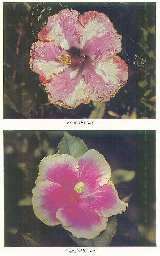 |
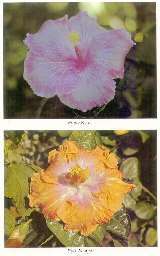 |
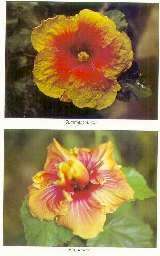 |
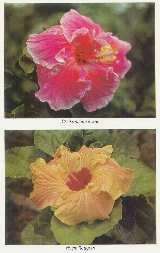 |
Prince Kuhio (top)
and Angel's Delight |
Pretty Baby and
Bob Waegner |
Summer Samba and
Firedance |
Christopher Howie and
Noela Reaburn |
The Essential
Plant Nutrients
All plants need at least 16 elements in order to grow and
bloom normally. Three of these essential elements, carbon
(C), hydrogen (H), and oxygen (O) are obtained by plants
from the air and water. Of the remaining 13 essential
plant nutrients, 6 are required by plants in relatively
large quantities and are called major elements, while the
other 7 are needed in much smaller quantities and are
called minor elements or trace elements. The 6 major
elements include nitrogen (N), phosphorus (P), potassium
(K), calcium (Ca), magnesium (Mg), and sulphur (S). The 7
minor elements are iron (Fe), manganese (Mn), zinc (Zn),
copper (Cu), boron (B), molybdenum (Mo), and. chlorine
(Cl).
The various nutrients play different roles in the
growth and development of plants. Here are what some of
the principal plant foods do:
Nitrogen is the growth element. It is
essential for the formation of protein and chlorophyll
and is required for leaf and stem development. Nitrogen
imparts a dark green colour to plants, but too much
nitrogen results in excessive vegetative growth at the
expense of flowering.
Phosphorus is important in root
formation, energy storage, and seed production. It
promotes the rapid development of roots by young plants.
Potassium is important for the
formation of plant tissue and flowers, and it helps
strengthen stem and leaf growth. Potassium acts as a
general tonic and imparts increased vigour and disease
resistance to plants.
Magnesium is an essential part of the
chlorophyll molecule. it is also important in seed
production and aids in the absorption of other nutrients.
Deficiency Symptoms
A deficiency of any one or more of the 16
essential elements will cause a plant to show symptoms of
abnormal growth, such as yellowish leaves (chlorosis),
die-back of twigs or dead areas in the leaves (necrosis),
reduced leaf size, and distorted growth. There are
different and distinct deficiency symptoms for each of
the essential elements. The amateur gardener will often
find it difficult to distinguish or separate one
deficiency from another. Many of the deficiencies produce
symptoms which appear similar to the untrained observer,
and different plants with the very same deficiency will
show slightly different symptoms. Learning to recognize
each of the more commonly seen deficiencies takes
practice and requires experience and familiarity with the
plants being grown.
Most of the major element deficiencies show up on the
old or lower leaves of a plant, while minor element
deficiencies are observed in the newer leaves toward the
tips of twigs. If a complete balanced fertilizer is
applied regularly, deficiencies of nitrogen, phosphorous,
and potassium will be uncommon.
Here are the most commonly seen nutritional
deficiencies of hibiscus:
Nitrogen: The mature leaves become
chlorotic (yellowish). Leaves are evenly affected,
including their veins, progressing from light green to
yellow.
Potassium: The older leaves become
scorched (brown) at their tips and edges but otherwise
remain green.
Magnesium: The older leaves turn
bronze yellow with green persisting at their tips and
lower central vein areas.
Iron: The young leaves turn a yellow
or cream colour but their veins remain green. The leaves
may be smaller than normal.
Manganese: Similar to iron
deficiency. The young leaves turn yellow-green while
their veins remain dark, but the green areas along the
veins and veinlets are wider than with iron deficiency
and there is no reduction in leaf size.
Zinc: The new leaves are small,
closely-spaced, and pale or chlorotic, and they are often
twisted to one side and crinkled in appearance.
Molybdenum: Older and then younger
leaves may become mottled. Younger leaves become long and
leathery and may be curled or twisted. This is a
condition known as "strap leaf" in which wide
ieaves become narrow with their veins almost parallel,
and blossoms may also be deformed. Moiybdenum deficiency
will sometimes appear and disappear sporadically for
reasons not yet known, the symptoms clearing up on their
own without any special treatment. These symptoms are
somewhat similar to those of herbicide (weed killer)
damage and should not be confused with the distortion
resulting therefrom.
Understanding the Fertilizer
Label
A fertilizer is a substance used for the purpose of
supplying one or more of the elements essential for
normal plant growth and development.
The analysis tells you the percentage
by weight of nitrogen, phosphorus and potash in the
fertilizer you buy. Analysis of a fertilizer appears on
the bag or label as three numbers, such as 6-6-6, for
example. The first number indicates the percentage of
nitrogen (N), the second number gives the percentage of
phosphorus (P), and the third number indicates the
percentage of potassium (K).
A complete fertilizer contains
nitrogen, phosphorus, and potash, while an incomplete
fertilizer contains one or two of these nutrients but not
all three. Note that the term complete as applied to
fertilizer does not mean that a product contains all the
essential major and minor elements, but only that all
three primary plant nutrients are present. A fertilizer
may be complete and still be lacking other important
nutrients such as magnesium, iron, or zinc.
A balanced fertilizer, as the term is
used here, contains nitrogen, phosphorus and potash, with
nitrogen and potash present in about the same percentages
while the percentage of phosphorus may be lower. Thus, a
6-6-6 or 7-2-7 fertilizer would be considered a complete
balanced fertilizer. (Some people refer to a fertilizer
as balanced only when all three primary nutrients are
present in equal amounts.)
Fertilizer ratio refers to the
relative amounts of nitrogen, phosphorus and potash
contained in the fertilizer. A 4-6-8 fertilizer contains
1 1/2 times as much phosphorus as nitrogen and twice as
much potash as nitrogen, and it could therefore be called
a 1-1 1/2-2 ratio fertilizer. Any other 1-1 1/2-2 ratio
fertilizer, such as 6-9-1 2, would provide the same
quantities of the three primary nutrients if the rate of
application was adjusted properly. For example, 2 cups of
6-9-12 would provide the same amount of N,P, and K as 3
cups of 4-6-8. Thus, the 6-9-1 2 fertilizer is
essentially the same as the 4-6-8, all other factors
being equal, but each fertilizer would be used at a
different rate.
The fertilizer label contains
valuable information. Unfortunately, the home gardener
usually pays little attention to it. You should make it a
practice to read the label when you shop for fertilizer.
The purpose of the fertilizer label is to tell you what
you are buying. You can select the fertilizer which is
best for your plants only if you understand the
information on the tag.
Sources of nitrogen. The fertilizer
label lists four forms of nitrogen which together make up
the total nitrogen percentage in the fertilizer: nitrate
nitrogen, ammoniacal nitrogen, water soluble organic
nitrogen, and water insoluble nitrogen.
Plants can absorb nitrogen in the nitrate and
ammoniacal forms only. Nitrate nitrogen is easily leached
out of the root zone of plants by heavy rains. Ammoniacal
nitrogen is more resistant to leaching than nitrate
nitrogen, but it is converted to the nitrate form fairly
rapidly, in a period of two to four weeks, by bacteria in
the soil. Ammoniacal nitrogen is preferred over nitrate
nitrogen for hibiscus because of its greater resistance
to leaching and because it seems to benefit flowering.
Water soluble organic nitrogen changes to ammoniacal
nitrogen within a few days after its application to the
soil. For this reason, the water soluble organic nitrogen
reported on the fertilizer label should be considered as
the equivalent of ammoniacal nitrogen. The principal
source of water soluble organic nitrogen is urea. Urea is
not a natural organic but is synthetically made.
Water insoluble nitrogen comes almost entirely from
natural organic sources, such as seed meals, sewage
sludge, and tankages. It must be converted to ammoniacal
nitrogen by soil organisms before it can be used by
plants, and the conversion takes place gradually. Because
of its slow release properties and resistance to
leaching, some water insoluble nitrogen is desirable in
the fertilizer, even though this form of nitrogen is more
expensive than the others.
Phosphorus. Most plants, including
hibiscus, do not require nearly as much phosphorus as
nitrogen or potassium. Phosphorus applied to the soil
will not leach out and remains available for a long
period. Too much phosphorus, especially on alkaline
soils, will tie up or render unavailable most minor
elements, especially iron. Once this situation occurs it
can take as long as 12 months to correct or lower the
phosphorus level in the soil. For this reason, a
fertilizer formula relativey low in phosphorus such as
7-2-7 is desirable.
Potassium. Potassium is especially
important for the production of good hibiscus blooms.
Muriate of potash (KCl), also known as potassium
chloride, is the cheapest source of potassium and is
therefore frequently found in fertilizers, but it is
undesirable because of its high chloride level. Sulphate
of potash or sulphate of potash-magnesium are preferable
sources of potassium.
If magnesium deficiency occurs,
magnesium sulphate (epsom salts) should be applied. Soil
applications of magnesium will often have no immediate
effect if the deficiency is severe. Spraying the foliage
with a solution of 60 g (2 ounces) of magnesium sulphate
per 4.5 L (1 gallon) of water may be helpful.
Sulphur. There is usually enough
sulphur present in the fertilizer and water which plants
receive to satisfy their requirements for this major
element. The sulphur may not be listed on the fertilizer
label but it is supplied by many fertilizer materials,
including sulphate of ammonia, sulphate of potash, etc.
Sulphur may be listed as a secondary plant food if it is
added in order to make an acid-forming fertilizer, but
even if sulphur is not mentioned you do not have to worry
about it.
Calcium. If the pH of the soil is
kept in the proper range, there should be enough calcium
present for normal plant growth. If agricultural lime or
dolomite is applied as needed to keep the pH of the soil
above 5.5, you will not have to worry about calcium.
Dolomite also contains magnesium, which is desirable.
Trace Elements. It is advisable to
have all soils analysed by an authority before adding any
elements to the soil "just in case they may be
lacking", as these elements can become toxic to
plants if present in more than minute amounts in an
available form. "in an available form" means -
sometimes the elements are present in the requisite
amounts, but in a form that makes them available to the
plant. It is not much use adding more in such cases, but
changing the pH of the soil can prove the answer. As an
example, trace element deficiencies are often found in
soil that has been limed too heavily. Adding more
elements would have no effect as the lime would still
make them unavailable.
Increasing the acidity of the soil by adding sulphur
will greatly increase the availability of all trace
elements except molybdenum. Iron is one of the most
abundant minerals found in the soil, but only a small
amount of this is present in a form available to plants.
Chlorophyll, the green colouring matter of plants must
have iron for its formation, as iron deficiency quickly
shows up by chlorosis or yellowing of the leaves as their
supply of chlorophyll is not forthcoming. Now this does
not mean there is no iron in the soil. There is probably
plenty for the plant's needs but lime has increased the
pH until insoluble iron hydroxide forms which is not
available to the plants. Once the soil is acidified by
adding sulphur, the iron becomes soluble and available to
the plant.
| Click an image
to see the book page full-size - click the BACK
button to return |
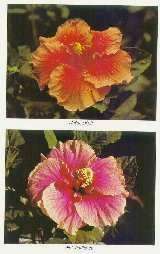 |
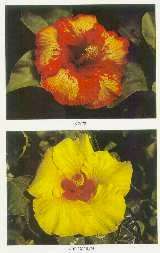 |
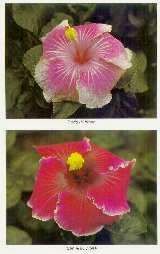 |
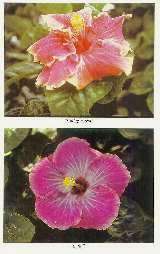 |
Wallace Keir (top)
and Pink Radiance |
Sonia and
Jan McIntyre (Saphire) |
Doris Hoffman and
Daniel D. Wolfe |
Shirley Howie and
Lani II |
Trace Elements -
Do Hibiscus Need These?
The answer to this is yes, but the next question is how
do we know if our soil is deficient in trace elements.
This can be observed in the growth of indicator plants.
The best indicator plant for boron deficiency is
beetroot. These will have split roots and some will die
off even though they have brightly coloured leaves.
Citrus fruits are also good guides, as the fruit are
dry and juiceless. To correct this soil deficiency of
boron (assuming that it hasn't an alkaiine reaction),
apply borax to the surface soil at the rate of 40 g to 10
m² (1 ounce to 10 sq. yards); the borax may be mixed
with soil for ease of application, or spray the foliage
with a borax solution, 30 g to 7 L (1 ounce to 1½
gallons) of water.
Care must be taken in the quantity of borax used. Only
use the quantities as indicated, otherwise injury or even
death of the plant treated may occur. Remember, do not
use foliage spray in the heat of the day.
Molybdenum deficiency is described as being associated
with hibiscus and is commonly called "Strap
leaf". Affected leaves, though dark green .in colour
are stunted and constricted laterally, veins are
prominent and distorted. The flowers of affected plants
do not open properly, and the petals are inclined to fuse
together. Affected plants should be sprayed with a
solution of Ammonium or Sodium Molybdate at the strength
of 30 g to 27 L (1 ounce to 6 gallons) of water
thoroughly wetting the leaves.
Copper and zinc are also important trace elements. The
specific effect of copper inplant metabolism is not known
definitely but it has been demonstrated as being present
in certain proteins having the character of enzymes.
These enzymes aid certain chemical and growth processes.
Copper does seem to promote the formation of Vitamin A.
Copper deficiency causes leaves to become yellow and fall
off and twigs to die back from the tips. Here again your
citrus trees are good indicator plants. If the above
phenomenon appears, your soil is generally copper
deficient.
Zinc deficiencies cause leaves to be small and bunched
together in the form of a rosette and plants are dwarfed.
To overcome the zinc deficiency plants should be sprayed
with a solution of Zinc Sulphate and Hydrated Lime, 45 g
(1½ ounces) Zinc Sulphate plus 20 g (¾ ounce) Hydrated
Lime per 4.5 L (1 gallon) of water. This spray is best
applied in the spring or early summer. Hibiscus are not
usually deficient in zinc if the year's culture has been
carried out.
Leaf Sign Language
| Leaves affected All
leaves
Old leaves
Young Leaves
|
Signs
Stunted, yellowish veins often red
Small, twisted, off colour
Mottled yellow, veins purplish
Grey, yellow blotches, veins green
Edges purplish and brittle
Wilted, water no help
Yellow, all veins green
Yellow, large veins green
Yellow, no veins green
Only base of leaf yellow
Tips and edges only yellow
|
Element Lacking Nitrogen
Zinc
Phosphorus
Magnesium
Potassium
Copper
Manganese
Iron
Sulphur
Boron
Calcium
|
Choosing a
Fertilizer
Some growers use different analysis fertilizers at
different times of the year but most hibiscus growers use
a single fertilizer all year round with excellent
results. Any standard balanced fertilizer will probably
give satisfactory results: a 6-6-6 or 7-2-7 analysis
seems most popular. There are many good commercial
fertilizers available, and you may be. able to choose
from a number of products with the same analysis but with
other differences which will have an effect on the growth
and flowering of hibiscus.
| Click an image
to see the book page full-size - click the BACK
button to return |
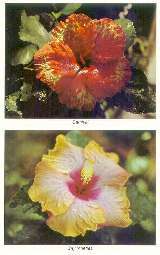 |
 |
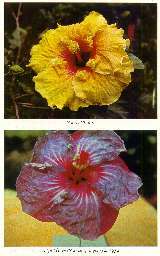 |
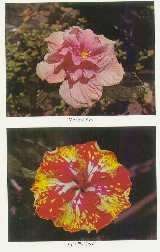 |
Carnival (top) and
Gay Nineties |
Ruby Brown and
Old Frankie |
Sandy Chunn and
Twilight Glow (1979 HOTY) |
Nancye Gow and
Lyle Phillips III |
Which
Fertilizers are Best
It is generally regarded by most hibiscus specialists
that Nitrophoska is the best fertilizer for hibiscus. It
is available in many N.P.K. formulae. Approximate N.P.K.
to be looking for is (12-5-14) to a higher K. (Potassium)
level of the N.P.K.
The simplest approach to hibiscus fertilizing,
obviously, is to use a single.formulation all year round.
A complete balanced fertilizer such as 6-6-6 or 8-8-8
will give good results, but on alkaline sandy soils a
fertilizer with slightly more potash than nitrogen may be
better. If you can find it, a fertilizer low in
phosphorus is much more desirable. The fertilizer you
select should contain more ammoniacal than nitrate
nitrogen, and at least 20% to 30% of the total nitrogen
should be in the water insoluble form. The fertilizer
should derive all its potassium from sources other than
muriate of potash in order to keep its chlorine content
as low as possible.
A balanced mixture of nitrogen, phosphorus and potash
will be inadequate unless it contains certain other
essential elements, such as magnesium, manganese, copper,
zinc, and iron. Magnesium is especially important and a
fertilizer should contain at least 2-4% magnesium as MgO
and smaller amounts of the minor elements. The use of a
fertilizer containing the minor elements in the proper
proportions will minimize the need for foliar sprays and
minor element additives. GU 49 iron is desirable as one
of the sources of iron. On alkaline soils an acid-forming
fertilizer may be beneficial.
Applying the Fertilizer
The key to success with hibiscus is to
fertilize lightly and often. The idea is to maintain a
fairly constant supply of nutrients at a level which
promotes good blooming. Hibiscus will not bloom well if
they are given either too much or too little nitrogen.
The proper amount of fertilizer for a given plant is not
absolute but depends upon a number of factors, including
the size of the plant and the conditions under which it
is growing. Plants growing in full sun need more
fertilizer than plants growing in part shade, and
hibiscus need more fertilizer in the summer than they do
in the winter, since they grow relatively slowly in the
shorter and cooler days of winter.
How often to fertilize. Hibiscus
should be fertilized frequently, at least once a month
throughout the growing season, and the schedule should be
kept up regularly. Heavy rains will leach nutrients out
of the root zone of plants so it is recommended that
fertilizer be applied somewhat more often during the
growing season. Remember that numerous light applications
of fertilizer are always better than a few heavy
applications.
How much fertilizer to apply depends
upon a number of factors, including the size of the
plants, the frequency of application, the time of the
year, and the analysis of the fertilizer being used. If
your plants are not flowering when they should be but are
lush and dark green and are growing vigorously, you may
be applying too much fertilizer high in nitrogen. On the
other hand, if your plants are flowering but only poorly
and are stunted and light green or yellowish, you may not
be applying enough fertilizer.
As a general rule, established hibiscus plants may
each be given from 1/4 cup of fertilizer once a month,
but small newly planted hibiscus should be given much
less than this. If you use a high analysis fertilizer you
should also apply proportionately less. Remember that
plants need very little fertilizer in the winter months.
How to apply. The fertilizer can be
applied directly on top of the soil or mulch. It should
be sprinkled evenly under and slightly beyond the spread
of the branches, but it should be kept off the foliage
and well away from the trunks of the plants. A good rule
is to apply the fertilizer in a circle which extends from
halfway in from the edge of the drip line to an equal
distance beyond.
Never apply fertilizer to dry soil. Be sure to water
your hibiscus well before and after fertilizing to reduce
the chance of burning your plants. Never depend on future
rains.
Salt burn. Too much fertilizer or
inadequate watering when the fertilizer is applied may
result in an accumulation of soluble salts in the soil,
causing damage to roots and marginal or tip burn on the
leaves. The symptoms of fertilizer burn are the same as
those of drought, since plants cannot absorb water if
excessive salts are present in the soil.
Liquid Fertilizer
There are several commercial fertilizers available which
are dissolved in water and applied as a soil drench, and
these liquid fertilizers may be used in place of or in
addition to dry fertilizers. Liquid fertilizers are not
used much, however, since they are generally more costly
and more troublesome to apply than the usual dry
fertilizers.
Plants that are weakened due to disease or nematodes,
transplanting or water or cold damage will benefit from
liquid fertilizer applied to the foliage. Three foliar
applications of a complete fertilizer one or two weeks
apart should be sufficient.
Correcting Minor Element
Deficiencies
Hibiscus, like all other plants, need small amounts of
the 7 minor elements in order to grow properly. Plants
with minor element deficiencies will not bloom well and
will decline in appearance and health. The correction of
a severe deficiency, if it is allowed to develop, may
take many months.
Iron deficiency is the most common minor element
deficiency of hibiscus, although deficiencies of
manganese, zinc, and molybdenum also occur fairly often.
The symptoms of these deficiencies have been described
earlier in this chapter. Boron and copper must be
supplied as well, but chlorine is never lacking because
of its presence in water and fertilizer.
The symptoms of any minor element deficiency show up
on the new or younger leaves of a plant. After the
deficiency is corrected the new growth will be normal in
appearance, the leaves which matured during the period of
deficiency will retain their abnormal appearance but are
no longer reason for concern.
Effect of soil pH. Minor element
deficiencies are much more common on alkaline than on
acid soils. Nutrients may be present in the soil and yet
unavailable to the plants, and the pH of the soil is an
important factor in this matter. On alkaline soils, soil
applications of certain minor elements will be relatively
ineffective, and foliar applications may be essential for
proper growth.
Soil applications of iron are not usually effective
unless the iron is applied in a form called GU 49 iron or
iron chelates.
Manganese, zinc, and copper can be effectively applied
to acid soils, but these three essential elements must be
supplied by means of foliar applications if the plants
are growing in alkaline or neutral soils. Boron and
molybdenum can be effectively applied to soils over a
wide range of pH.
All the minor elements can be applied, if desired, by
spraying the foliage. Foliar sprays are quicker acting
but do not last as long as soil applications of the minor
elements.
Acid soils. Most garden fertilizers
contain small quantities of the minor elements, and on
acid soils regular applications of such a fertilizer
should satisfy the needs of hibiscus plants. Suitable
levels of minor elements in a fertilizer would be 1 %
iron and manganese, 0.5% zinc, 0.2% copper, and 0.1%
boron. (Plants require so little molybdenum that its
application will seldom be necessary.) These figures are
general guide lines only; the amounts may vary and the
fertilizer still be perfectly satisfactory.
If it is determined that supplemental soil
applications of minor elements are needed, several good
formulations containing all these minerals (plus
magnesium) in the proper proportions are commercially
available, (e.g. Esminel or other frittered trace element
mixtures). Some growers recommend spraying the foliage
occasionally with a general purpose minor element
solution during the growing season, and supplemental
applications of GU 49 iron or chelated iron one or more
times a year may be beneficial.
Alkaline soils. In order to correct
and avoid deficiency problems on alkaline soils, it will
probably be necessary to apply GU 49 iron or chelated
iron occasionally and to spray the foliage regularly with
a minor element solution which is high in iron and
manganese and contains smaller but substantial amounts of
zinc and copper. Spray with each new flush of growth or
every 8 weeks during the spring and summer when the
plants are rapidly growing. It is important to spray the
underside of the leaves as well as their tops. A small
quantity of spreader-sticker or liquid dish detergent
one-quarter teaspoon per 4.5 L (1 gallon) added to the
spray solution will help to ensure good coverage of the
leaf surfaces.
Minor element nutritional sprays are available as
liquids and as dry soluble powders. Care should be used
in applying these sprays, for they will permanently stain
paint or concrete. When applying nutritional sprays, do
not exceed the manufacturer's recommendation as to the
amount to be used or you will risk injury to your plants.
You can minimize minor element deficiencies on
alkaline soils by planting your hibiscus properly. Dig a
large hole and mix large amounts of organic materials
such as peat, manure, or compost into the original soil.
This will tend to acidify the soil in which the plant
roots are growing. The regular use of an acid-forming
fertilizer may also be helpful.
Correcting specific deficiencies. An
experienced person will sometimes recognize specific
minor element deficiencies and treat them separately. Use
of the following materials is recommended:
Iron deficiency: Use chelated iron or
GU 49 iron.
Manganese deficiency: Use manganese
sulphate. Apply 1/4 to 1 cup per plant twice a year until
the deficiency is corrected, or spray with a solution of
30 g (1 ounce) of manganese sulphate plus one teaspoon of
hydrated lime in 9 litres (2 gallons) of water.
Zinc deficiency: Apply zinc sulphate.
On alkaline soils spray with a solution of 30 g (1 ounce)
of zinc sulphate plus 10 g (l/3 ounce) of hydrated lime
in 9 litres (2 gallons) of water.
Copper deficiency: Use copper
sulphate. For a foliar spray, dissolve 30 g (1 ounce) of
copper sulphate plus 10 g (l/3 ounce) of hydrated lime in
9litres (2 gallons) of water. Copper sulphate alone will
burn the foliage.
Boron deficiency: Apply borax, 30 g
per 9 m² (1 ounce per 100 square feet) or use solubor.
Molybdenum deficiency: Use very small
amounts of sodium molybdate.
Potassium for Quality Blooms
Some of the most successful hibiscus
growers have concluded that potassium, when present in
amounts larger than the nitrogen supply (approximately 1
part nitrogen to 3 parts potassium), has a strong
beneficial effect on flower quality, colour, and
condition. Accordingly, these growers often adjust their
fertilizing practices to provide their plants with more
potassium than nitrogen during the hibiscus show season.
The use of potassium sulphate in small quantities is
an effective means of building up potassium levels to the
proper proportions for the highest quality blooms. One
method of getting hibiscus to produce good blooms is to
alternate the regular fertilizer with potassium sulphate
every two weeks during the growing season. Use potassium
sulphate at the rate of ½ cup approximately 120 g (4
ounces) to 22.5 L (5 gallons) of water, and apply one cup
of this solution to each mature plant.
If all this seems complicated, remember that many
growers use a single balanced fertilizer all year round
and produce fine quality blooms. Expert growers may
differ in their methods of fertilizing, but they all
agree that the key to success with hibiscus is to
fertilize lightly and often.
| Click an
image to see the book page full-size - click the
BACK button to return |
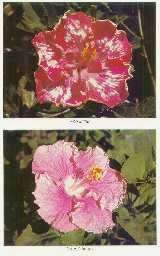 |
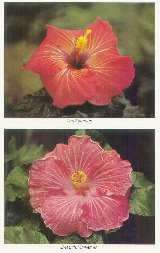 |
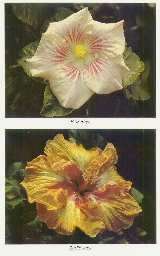 |
 |
Ann Miller (top)
and Three Cheers |
The Mohican and
Beautiful Dreamer |
Pink Rays and
Surfie Jack |
Big Tango and
Mrs J. O'sullivan |
Fertilizing
Container Grown Plants
Hibiscus which are grown in containers may be fertilized
in much the same manner as plants in the ground. The
simplest approach is to use the same fertilizer as you
would use for garden plants. Plan to fertilize at least
once a month, applying 1/3 to ½ teaspoon to 20 cm (8 in)
pots, ½ to 1 teaspoon to 25 cm (10 in) pots and 1½ to 2
teaspoons to 30 cm (12 in) pots.
The commercial fertilizers which are sold for use on
house plants and potted plants are also suitable for
container grown hibiscus, provided that they contain
magnesium and small amounts of the minor elements in
addition to the three primary nutrients.
Hibiscus in pots are susceptible to residue salt
burning if they are not watered properly, due to the
accumulation of salts from both fertilizer and water. To
avoid burning your plants in containers, water them
heavily, so that some water comes through the drainage
holes and leaches out any excess salts, and be sure to
water well after each application of fertilizer.
Container grown plants may benefit, just the same as
garden plants, from periodic spraying with minor element
solutions and occasional applications of GU 49 iron or
iron chelates.
Compost and Manure
One of the best ways to improve the quality of poor soil,
whether sandy or heavy, is by the addition of organic
material through the use of animal manures or compost.
Manures and compost are used primarily for their soil
conditioning value. They can be of great benefit to the
hibiscus grower by adding humus to the garden, but their
use will not eliminate the need for a regular fertilizer
program.
Well drained sandy soils are generally low in
fertility and dry out quickly. The addition of organic
matter will increase a soil's fertility by providing a
favourable environment for beneficial food manufacturing
micro-organisms and by reducing the loss of plant
nutrients due to leaching. The ability of the soil to
hold water will also be greatly increased by the addition
of humus. Organic matter decomposes rapidly and
ultimately disappears completely in well drained sandy
soils. Thus, it may be necessary to add organic materials
each month to maintain a good quality soil. The use of an
organic mulch such as decomposed or weathered cypress or
pine bark helps to keep an adequate level of humus in the
soil.
Animal manures such as cow, sheep,
horse, or chicken provide excellent organic materials for
the hibiscus grower. Composting improves all manures.
Inter-layering about 15-20 cm (6-8 in) of manure with
5 cm (2 in) of soil into a pile several feet high,
maintained in a moist condition for 6 to 8 weeks, makes
an excellent product when the pile is mixed for usage.
Although manures are used primarily for their soil
conditioning value, they are useful also as fertilizer
materials, especially for newly transplanted hibiscus
which require frequent watering. Manures, sewage sludges,
and mature composts can be mixed directly with the soil
before setting in plants. The nutrients in these
materials resist leaching and are released slowly, so
there is little risk of burning the plants. The exception
is unleached chicken manure, which is quite high in
rapidly available nutrients and which requires careful
usage to avoid injury to plants.
The compost pile makes use of kitchen and garden waste
and is a valuable source of organic material for the
hibiscus grower. It may be started at any time of the
year.
The compost heap needs some kind of container with
vertical sides, whether of boards or wire fencing
supported by stakes. Maintaining two small piles serves
the purpose better than one very large pile.
To start the compost heap, build a 15-30 cm (6-8 in)
layer of fresh organic materials such as leaves, grass
clippings, plant prunings, natural ashes of wood or
charcoal (not from the incinerator because of the
kerosine factor) and kitchen wastes such as coffee
grounds and egg shells. Weeds with ripe seeds, resinous
plant material, greasy animal fats, and diseased plants
should be avoided. Animal manures and certain fruit and
vegetable wastes could draw flies and should be covered
or buried within the pile.
Fertilizer added from layer to layer as the pile
builds will hasten the decomposition process. Sprinkle
about two cups of a complete fertilizer over the compost
and water thoroughly. You can, if you wish, add a 2-5 cm
(1-2 in) layer of topsoil and a handful of dolomite in
addition to the fertilizer.
Keep repeating this layering until the pile fills the
bin. Air and moisture are important to the decomposition
process, so turn the material occasionally with a spade
and water frequently, keeping the pile moist but not
water logged. A coarse screen chimney can be placed
vertically in the centre to ensure better aeration, or
the heap can be ventilated by pushing a rake handle down
through it in several places.
The compost will be ready to be spaded onto the garden
soil within 2 to 6 months, depending on the waste
materials used and the time of the year. Succulent green
materials will decay faster than dry ripened growth, and
the compost will break down faster in the summer than in
the winter. The final product, when the original waste
materials have decomposed to the point when they are no
longer recognisable for what they were, is humus.
One good way to maintain a steady supply of mature
compost is to build a series of three connecting bins, 90
cm, 60 cm, and 30 cm (3 feet, 2 feet and 1 foot) in
height. Begin the composting process in the tallest bin.
In six weeks, blend the compost and transfer it to the 60
cm (2 ft) bin and start another pile in the tall bin. The
compost will reduce in volume as it breaks down. In
another six weeks, transfer the material from the middle
bin to the 30 cm (1 ft) bin, where it can be stored until
needed.
|